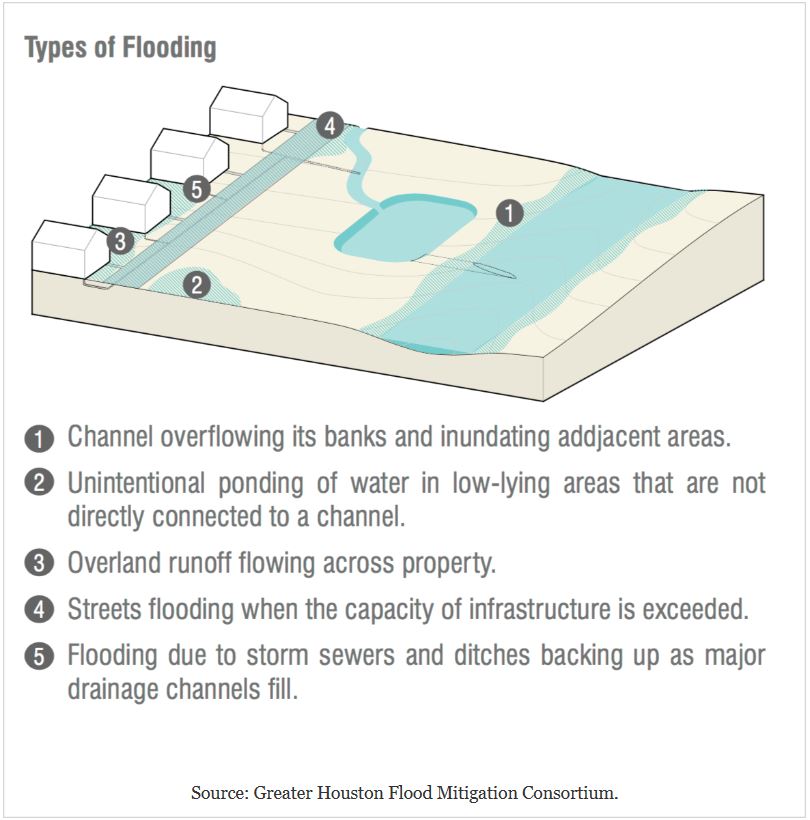Considerations for neighborhood protected by levee
Residents and potential home buyers in areas where protection from flooding is provided by levee systems may need to consider carefully the actual risk, which may be higher than many assume. Levees are designed to reduce (but not eliminate) flooding risk. There may often be no requirement for residents to be provided with an assessment of the specific risk by developers. However, the presence of levees indicates that significant drainage issues exist in the area.
The levee system (usually composed of earthen berms, flood gates, and pumps) must perform two functions successfully to prevent flooding:
The levee system (usually composed of earthen berms, flood gates, and pumps) must perform two functions successfully to prevent flooding:
- Hold back flood water from outside of the protected area
- Remove water accumulating inside the protected area
Failure of the levee system can result from multiple factors such as:
- Berms must have sufficient height and strength to hold back impinging flood water
- Gates must operate properly and be opened/closed at the appropriate times
- Pumps must operate properly and have sufficient capacity in order to remove water accumulating inside the protected area
The Harvey experience in Fort Bend county provides valuable real-world lessons for these situations, as described in the Houston Chronicle article by Emily Foxhall dated February 23, 2018. The article is entitled "For two newcomers, a crash course in levees and girding for the next Harvey - 2 appointees bear responsibility for protecting neighbors from floods."
In Fort Bend county there are 20 levee-protected areas built and maintained by local Levee Improvement Districts (LID). They are located in the Brazos floodplain adjacent to Oyster Creek and the Brazos River and include many large and popular subdivisions in and around Sugar Land (see Map #1 below).
The detailed topography from the Digital Elevation Model (DEM) shows that the levee-protected neighborhoods occupy a pronounced low region between waterways. This emphasizes the need for the levees and may have had some influence in determining where flooding from Harvey was most concentrated.
On the Flood Insurance Risk Maps (FIRM) these areas are classified as Zone X - Protected by Levee. However these zones are not low risk but are actually classified as moderate risk by FEMA and purchase of flood insurance is strongly recommended. Lower cost Preferred Risk Policies are available due to the protection provided by the levees. However, since the Fort Bend levees were all built to the 1-percent annual chance flood standard, none of the protected areas were classified as Special Flood Hazard Areas and residents did not have to be notified of the insurance requirement.
The detailed topography from the Digital Elevation Model (DEM) shows that the levee-protected neighborhoods occupy a pronounced low region between waterways. This emphasizes the need for the levees and may have had some influence in determining where flooding from Harvey was most concentrated.
On the Flood Insurance Risk Maps (FIRM) these areas are classified as Zone X - Protected by Levee. However these zones are not low risk but are actually classified as moderate risk by FEMA and purchase of flood insurance is strongly recommended. Lower cost Preferred Risk Policies are available due to the protection provided by the levees. However, since the Fort Bend levees were all built to the 1-percent annual chance flood standard, none of the protected areas were classified as Special Flood Hazard Areas and residents did not have to be notified of the insurance requirement.
Hurricane Harvey tested the effectiveness of these levee systems. During Harvey mandatory evacuations were ordered for some Fort Bend subdivisions due to fears that levees could fail. Thirteen of the twenty levee-protected areas had no homes flooded by Harvey, however the other seven had as many as 32% of the total homes flooded. Overall there were over 1000 homes reported flooded in the Fort Bend levee-protected neighborhoods.
The LID 19 area including the Riverstone development was particularly affected. Riverstone is located in a significantly low portion of the floodplain immediately next to the Brazos river floodway (see Map #3 below).
The Harvey flooding in Riverstone was featured in a December 16, 2017 Houston Chronicle article by Emily Foxhall entitled "Harvey overwhelmed some levee systems. Future storms could do worse."
https://www.houstonchronicle.com/news/houston-texas/houston/article/Harvey-overwhelmed-levee-systems-Future-storms-12424740.php
Readers, if you live in a levee-protected area are you satisfied that you were properly informed regarding the associated flooding risk? If you are a prospective Fort Bend County home buyer did the recent Hurricane Harvey experience cause you to re-consider?
Please refer to the link below for information from FEMA regarding all types of levee-protected areas.
https://www.fema.gov/media-library-data/20130726-1623-20490-5510/1.15_levee_information_for_mortgage_lenders.txt







Comments
Post a Comment